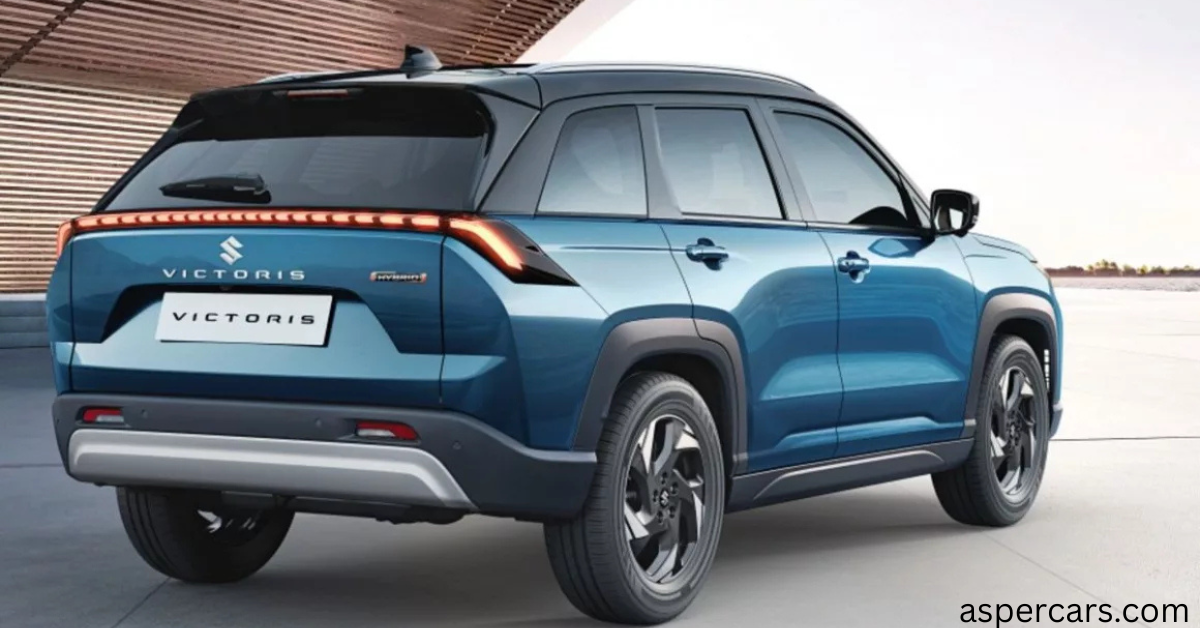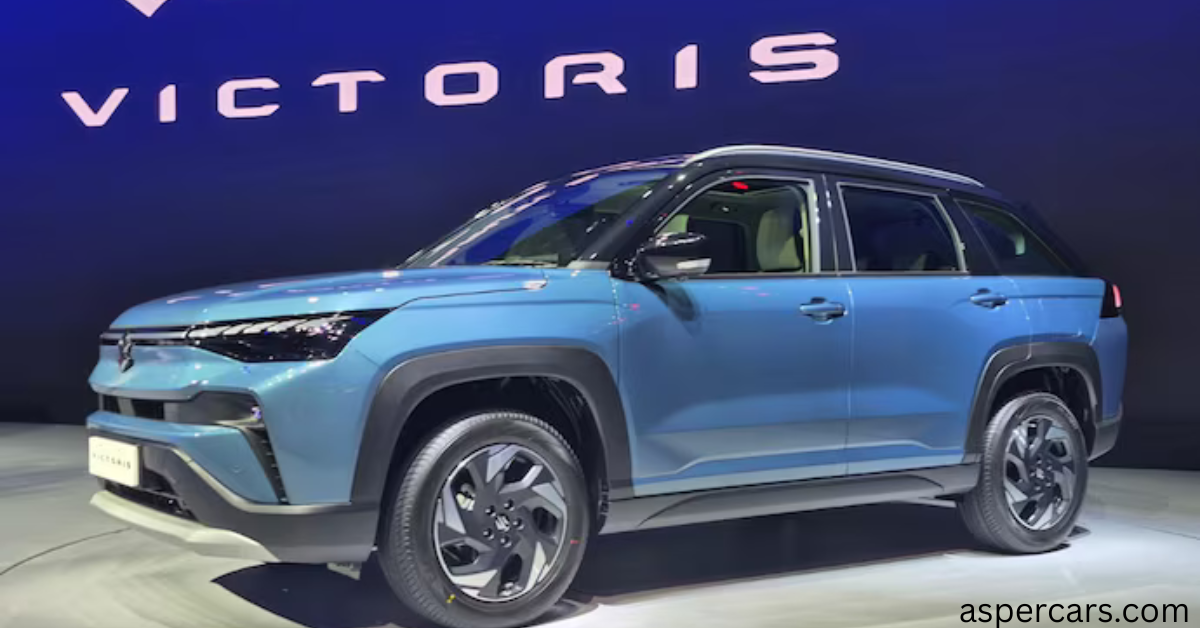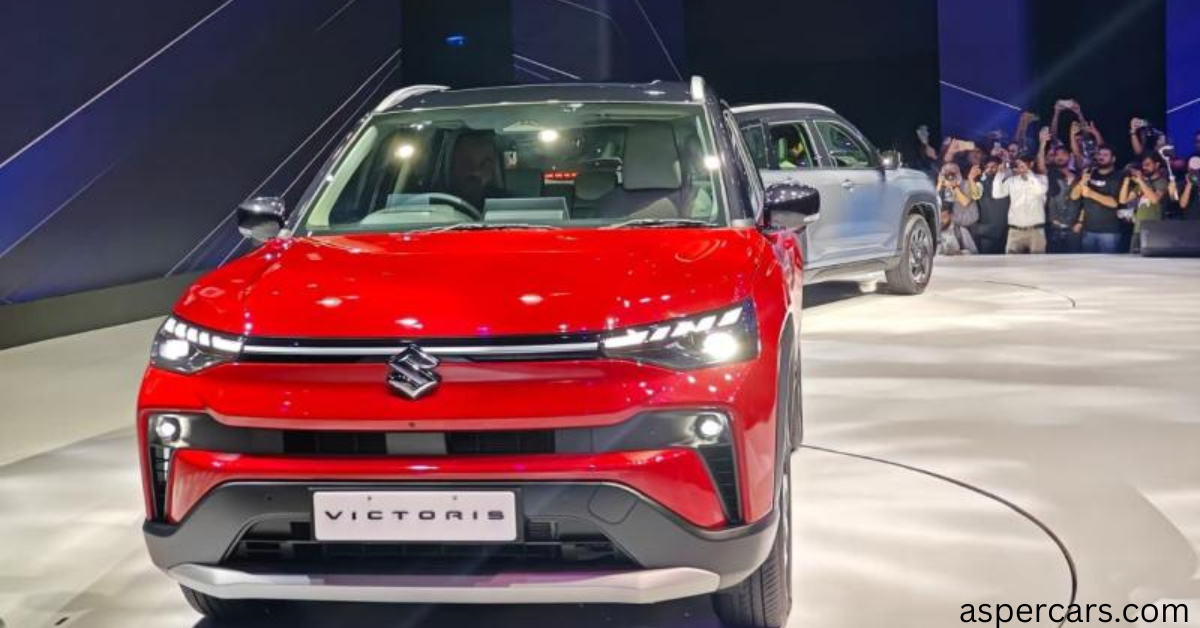The past 10 years approach of Maruti Suzuki has been to expand its product range beyond compact hatchbacks and entry sedans into the high volume SUV segment. The most recent product of that plan is the Victoris: a 5-seater SUV, placed between smaller-SUV and bigger family SUVs. It introduces some of the features found in higher-end models Level-2 ADAS, powerful hybrid powertrain, capability to run on multiple fuels (petrol + CNG) and an optional AWD system at an affordable price that does not diminish the volume advantage that Maruti had. The company is marketing Victoris as the fusion of daily functionality and the latest safety and entertainment technology

Design language and exterior
Victoris embraces a contemporary SUV design that has a comparatively upright greenhouse and bold front fascia. Design highlights include:
- The outstanding grille with slender headlamps of LEDs and L-shaped daytime running lights.
- Body flanks are sculpted that visually extend the car and provide it with a planted appearance.
- Available alloy designs up to 17 18 inches (depending on variant) and muscular wheelarch treatment.
- Physical indicators – high ground clearance, short overhangs and a power tailgate with gesture control on upper trims.
Its styling is mainstream with a few upscale elements (chrome accents, a fake skid plate) to appeal to people who are upgrading their hatchback purchases and also those looking to sell their older SUVs.
Interior: packaging, material and comfort.
Maruti has made priorities on space and family comfort. Inside Victoris you’ll find:
- A horizontally-laid dashboard that has a broad feel to the cabin.
- The infotainment (depending on variant) is a large central touchscreen that features wireless Android Auto/Apple carplay, embedded navigation (or optional immersive audio system) with Infinity speakers and Dolby Atmos (top trims).
Large shoulder and headroom in front and rear seat; rear bench is made to accommodate three passengers on short to medium trips. - Practical touches Cooled glovebox, several USB ports, large door pockets, flat floor (in some models) to enhance rear foot space.
- The segment has competitive quality — soft-touch materials on the dash top and well-fitted plastics everywhere; leather/ette upholstery on upper trims.
Powertrains and performance
The diversity of powertrain choices offered by Victoris is one of its largest selling points — serving fuel economy hunters, tech fans and consumers desiring AWD functionality.
High level powertrains:
- 1.5-litre K15C petrol (mild-hybrid) – has either manuals or automatics; set up to suit city and highway.
- Strong Hybrid 1.5 e-CVT – provides the best fuel economy numbers in the class (Maximum 28.6 km/l in the hybrid e-CVT test cycle quoted by Maruti). This system combines a petrol engine and electric drive, as well as e-CVT, to achieve smooth and efficient driveability.
- The Petrol + Underfloor CNG – a dealer-fitted CNG model which offers excellent running costs, and focuses on customers with long daily mileage, or market of a mature CNG infrastructure. Combined petrol+CNG economy values given by Maruti are in the mid-20s km/kg equivalent.
- ALLGRIP AWD (selected petrol AT models) – AWD system of Maruti that gives it better traction in bad weather and some light off-road applications. AWD derivatives record slightly lower levels of economy because of the loss in the drive line.
Performance notes: Victoris is tuned to refine and fuel economy instead of performance in the day-to-day use. The hybrid model is the most economical and smooth to ride and petrol-AT provides reasonable city responsiveness and highway stability. The versions of AWD compromise some economy with assurance in low traction situations.
Driver assistance and safety.
India has turned into a battlefield of safety. Victoris est fortius Excusatius:
- Safety at structure: Maruti places Victoris to attain good safety scores, with the tensile steel structure of high tensile and various standard safety provisions. There are initial signs of 5-star ratings in targeting agencies (High safety standards are mentioned by Maruti).
- Passive safety: Multiple airbags (front + side + curtain on top trims), ISOFIX child-seat anchors, seatbelt reminders and high-strength body structure.
- Active driver aids (ADAS): Victoris comes with Level-2 ADAS on high trims adaptive cruise control, lane-keep assist, automatic emergency braking (AEB) with pedestrian and cyclist detection, blind-spot monitoring and rear cross-traffic alert. ADAS design to Indian roads Calibration is a process that is still in the process of being applied throughout the industry; early testers found the systems to be competent on commuter roads, but recommended limited use on narrow roads.
- Extra features: 360 camera, tyre pressure sensor, auto-hold electronic parking brake, and hill-assist on AWD/AT models.
Infotainment & connectivity
Maruti has overextended in its technology to attract younger customers:
- Infotainment: A large floating touchscreen (dependent on variant), wireless smartphone mirroring, inbuilt voice assistant, OTA update option on selected features and optional premium Infinity sound system with Dolby Atmos.
- Smart car functionality: Remote car controls, geo-fencing, driving analytics, emergency support and remote diagnostics (included in the Maruti connected services package (some features on a subscription basis).
- UX: The system puts an emphasis on making the system easy-to-use, with the logical menus; physical HVAC control is still present, but it is not explicitly made to be tactilely adjusted during driving.
Utilitarianism, area and application.
Victoris is based on a daily-driver in the family:
- Boot space: Large enough by SUV 5-seater standards, and rear seats can be folded to form a convenient cargo space to transport weekend luggage or groceries.
- Ride/handling: Comfort-tuned suspension-bumps are absorbed, and regulated body roll gives safe highways operation. The steering is adjusted such that it is light in low speed and heavier in highways.
- Ownership and maintenance- Maruti has a large dealer and service network in India; Maruti also has long term service contracts and warranty option that contribute to the ownership tranquility.
Pricing and variants
An overview of pricing used at launch can be seen in the table shown below, as the number of variants is quite extensive, and the starting price ranges. Prices are on a case-by-case basis and shown as ex-showroom (taxes and special offers may apply; contact local dealers to determine actual on-road prices)
| Variant / Powertrain | Transmission | Drive | Approx. Starting Price (Ex-Showroom, INR) |
|---|---|---|---|
| Victoris LXi (Base petrol) | MT | 2WD | ₹10.49 lakh* |
| Victoris VXi (Mid petrol) | AT/MT | 2WD | ₹13.35 lakh* |
| Victoris ZXi / ZXi(O) (Feature mid/high) | AT | 2WD | ₹15.12–15.63 lakh* |
| Victoris ZXi+ / ZXi+(O) (Top petrol/hybrid/CNG) | e-CVT / AT | 2WD / AWD | ₹16–20 lakh* (Hybrid & AWD pricier) |
| Victoris Petrol + CNG | MT / AT | 2WD | + variant premium over petrol MT (competitive running cost). |
Prices are representative at starting point; on road taxes and dealer offers vary between cities will alter the ultimate price of purchase. Maruti has an authoritative configurator and local dealers when it comes to providing precise prices and up to date offers.

Technical specification table (abridged)
This specification table explains the most significant load carrying technical specifications that buyers consider when making comparisons between SUVs.
| Item | Specification (typical / range) |
|---|---|
| Platform | Maruti-developed platform (SUV architecture) |
| Engines | 1.462 L K15C petrol (mild hybrid); 1.490 L strong hybrid (e-CVT); factory CNG variant (underfloor) |
| Power / Torque | Petrol ~102 bhp / 139 Nm (approx. depending on tune); Hybrid combined higher torque feel (manufacturer figures vary). |
| Transmissions | 5/6-speed MT (depending on model), 6-speed AT, e-CVT (hybrid) |
| Drivetrain | 2WD standard; ALLGRIP AWD optional on selected ATs |
| Fuel economy (claimed) | Petrol (MT/AT) ~21 km/l; AWD ~19 km/l; Strong Hybrid ~28.6 km/l; Petrol+CNG ~27.0 km/kg (manufacturer claimed cycle figures). |
| Seating | 5 passengers |
| Safety | Multiple airbags, ABS with EBD, ESC, ADAS Level 2 on higher trims |
| Dimensions (approx.) | Length: mid-segment SUV (approx. 4.2–4.3 m class); exact dims vary by variant — see official brochure. |
Competitor analysis (momentary table and story)
Victoris is competing with a busy mid-sized SUV market: Hyundai Creta, Kia Seltos, Tata Harrier / Safari, MG Astor, Skoda Kushaq / Volkswagen Taigun (price overlap). The largest and most expensive competitors to Victoris are the Creta and Seltos.
| Model | Strong suit vs Victoris | Where Victoris has the edge |
|---|---|---|
| Hyundai Creta | Perceived premium fit & finish, established desirability | More fuel-efficient hybrid option; Maruti service network |
| Kia Seltos | Sportier styling, feature-rich variants | Maruti’s lower running cost (esp CNG); wider service reach |
| Tata Harrier / Safari | Larger body & diesel torque (if you want big SUV feel) | Victoris better fuel economy (esp hybrid), cheaper to buy/own |
| MG Astor | Tech & safety features | Maruti’s lower long-term running costs & broader sales/service network |
Story: Hyundai/Kia could still be a winner in terms of the most feature-packed cabin and a high quality feel. When the low running cost is important over the long term and the well known, extensive dealer/service network is highly important to you, and you would value hybrid economy or factory CNG, Victoris is highly competitive. The two differentiators that will aid Victoris in the segment are the availability of ADAS and an efficient hybrid version.
Ownership: operating expenses, guarantee and resale.
- Running costs: the various fuel options available at Victoris leave the buyer with a choice. The petrol and the mild-hybrid models have a standard Maruti fuel economy. The headline to buyers who are cost conscious per-km is the strong hybrid and factory CNG variants, which are focused on the mixed driving and CNG with the long steady commute with an easy-to-access CNG refuelling variant. The official claim numbers are to be viewed as the laboratory figures; the actual numbers are usually lower and yet competitive.
- Warranty and service: Maruti has a good network in India, thus making the network less difficult in terms of service and downtime. Maruti usually provides normal warranty schemes with paid extensions and paid maintenance plan – this can save a lot of unexpected expenses during 3-5 years.
- Resale: Because of brand acceptance and extensive service coverage, resale of Maruti cars normally has high values in India; a well-spec’d Victoris ought to be more of a value than some competitors over the medium term, particularly as long as fuel-efficient versions continue to be in demand.
Impression and first reviews in reality.
Preliminary reviewer opinion points out:
- Mileage and economy: The efficiency of the hybrid version (purported to reach 28.6 km/l) impressed both during controlled tests, and the factory version of CNG demonstrates very high running costs in areas where CNG is feasible.
- Safety & ADAS: Various reviews have commended the presence of Level-2 ADAS in this price bracket but have recommended that it should be used carefully and with knowledge- ADAS action differs depending on the road and traffic conditions.
- Comfort: Ride comfort, cabin ergonomics are competitive, according to some reviewers, there is body roll under aggressive cornering which exceeds a sporty SUV but is tolerable in family service.
- Value proposition: Starting at a very affordable low-lakh band and having technological/efficiency functionality comparable to higher-priced vehicles, critics typically conclude that Victoris is a value-based play into the contemporary SUV segment.
Who should buy a Victoris ?
One important candidate who can serve you well is Victoris in case you:
- Desire a family SUV that is fuel efficient with the choice of a hybrid or CNG.
- Be mainstream at a mainstream price.
- Like expanded service network and consistent operating expenses.
- Want real world everyday practicality rather than pure sportiness.
Think competitors (Hyundai/Kia/Tata) in case you highly value high-quality cabin, sporty handling or particular diesel torque feel (but Victoris is petrol/hybrid/CNG).

Strengths and weaknesses (in brief)
Strengths
- Wide selection of effective powertrains (strong hybrid, CNG, petrol).
- Higher trims such as level-2 ADAS and strong safety kit.
- Price competition and after sales network of Maruti.
Weaknesses
- Not targeted at customers who want to have a sporty drive – the handling is biased toward comfort.
- AWD/hybrid and best versions increase the price to areas that have higher end competitors (whose material and refinement might be better).
- The performance of actual ADAS will be determined by the maturity of the software, as well as road conditions; the purchasers should view ADAS as a supplement, rather than an alternative to careful driving.
Final verdict
Maruti Victoris is a well-balanced, practical SUV, which introduces high-tech fuel and ADAS into the budget range. To customers looking to be relatively economical and be safe and low-hustle in its ownership, Victoris would be an appealing option: it maintains its running costs low with hybrid or CNG options, but also has contemporary driver comforts and an appealing options list. In a fierce environment, the success of Victoris will depend on the effectiveness with which Maruti positions the highest end features and how consumers will trade the advantage of good service offered by the company with the relatively high-end touch of some competitors. Generally speaking, Victoris is quite aligned to what many of the Indian SUV consumers desire in 2025: efficiency, safety and reasonable technology at a reasonable price.